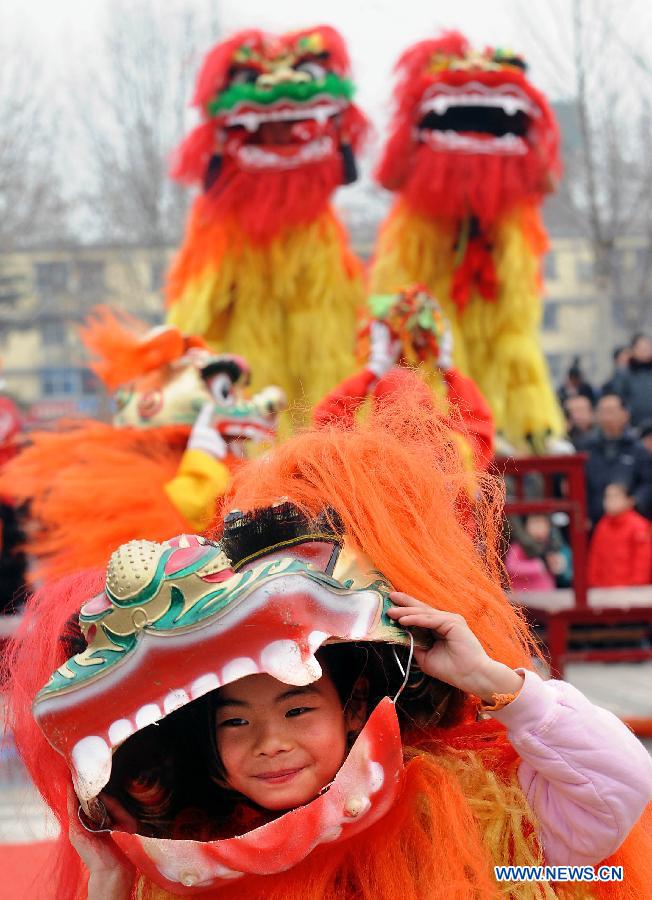
File photo taken on Feb. 27, 2010 shows a young folk artist attending a Lantern Festival Shehuo performance in Zhengzhou, capital of central China's Henan Province. The performance of Shehuo can be traced back to ancient rituals held by ancestors of the Chinese people to worship the earth, which they believe could bring good harvests and fortunes in return. With time, the primitive rituals evolved into the Shehuo festivity, a tribute to the Tudi Gong, a deity who holds sway over fortune and wealth. Most Shehuo performances take place around traditional Chinese festivals, especially at temple fairs of the Spring Festival and the Lantern Festival. [Xinhua/Wang Song] 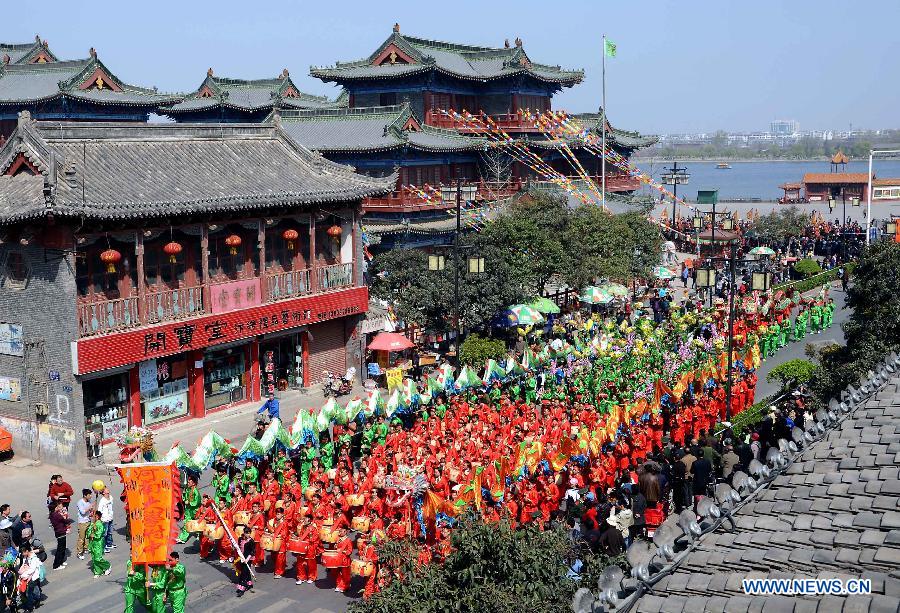
File photo taken on April 1, 2012 shows members of a Shehuo performance team attending a Qingming Festival parade in Kaifeng, central China's Henan Province. The performance of Shehuo can be traced back to ancient rituals held by ancestors of the Chinese people to worship the earth, which they believe could bring good harvests and fortunes in return. With time, the primitive rituals evolved into the Shehuo festivity, a tribute to the Tudi Gong, a deity who holds sway over fortune and wealth. Most Shehuo performances take place around traditional Chinese festivals, especially at temple fairs of the Spring Festival and the Lantern Festival. [Xinhua/Wang Song] |
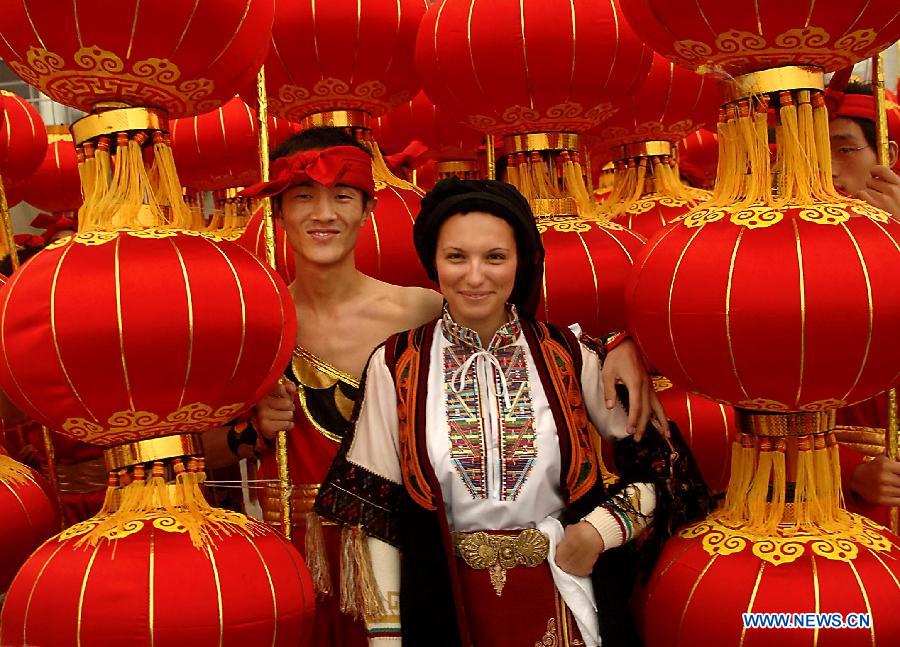
File photo taken on Sept. 27, 2007 shows a Spanish folk artist with a Shehuo performer at a carnival in Luoyang, central China's Henan Province. The performance of Shehuo can be traced back to ancient rituals held by ancestors of the Chinese people to worship the earth, which they believe could bring good harvests and fortunes in return. With time, the primitive rituals evolved into the Shehuo festivity, a tribute to the Tudi Gong, a deity who holds sway over fortune and wealth. Most Shehuo performances take place around traditional Chinese festivals, especially at temple fairs of the Spring Festival and the Lantern Festival. [Xinhua/Wang Song] |
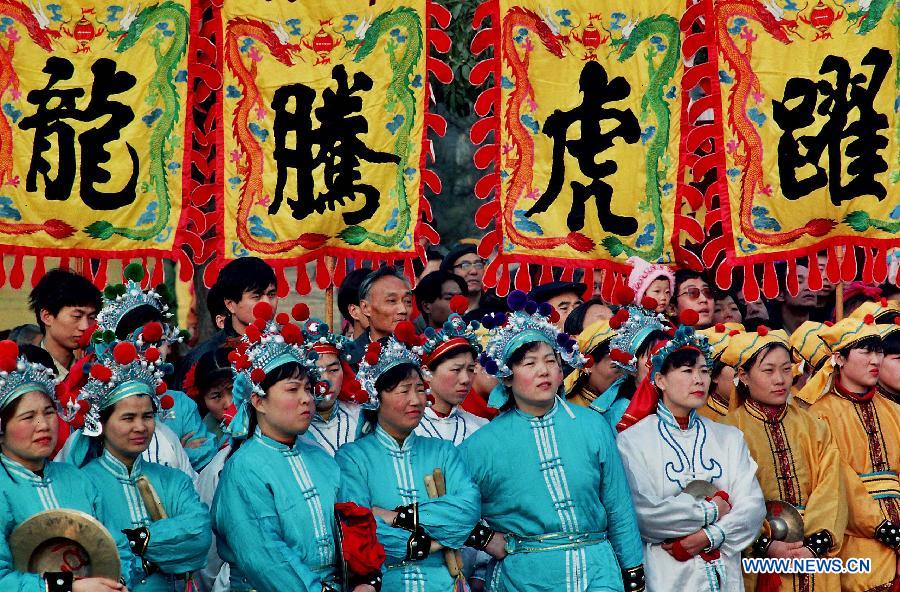
File photo taken on May 13, 1996 shows folk artists watching a Shehuo performance in Zhengzhou, capital of central China's Henan Province. The performance of Shehuo can be traced back to ancient rituals held by ancestors of the Chinese people to worship the earth, which they believe could bring good harvests and fortunes in return. With time, the primitive rituals evolved into the Shehuo festivity, a tribute to the Tudi Gong, a deity who holds sway over fortune and wealth. Most Shehuo performances take place around traditional Chinese festivals, especially at temple fairs of the Spring Festival and the Lantern Festival. [Xinhua/Wang Song] |
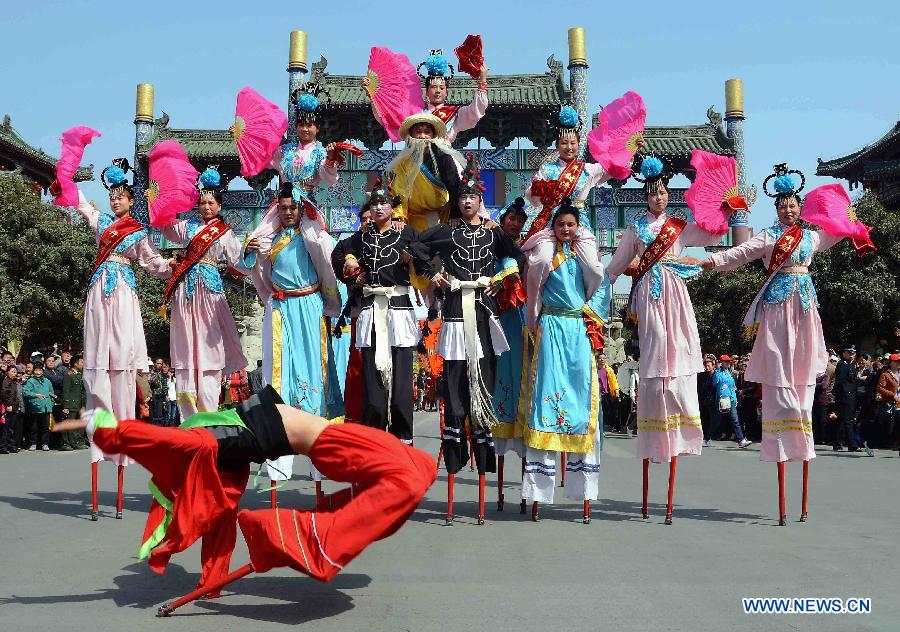
File photo taken on April 1, 2012 shows Shehuo performers stage a stilt show during a Qingming Festival parade in Kaifeng, central China's Henan Province. The performance of Shehuo can be traced back to ancient rituals held by ancestors of the Chinese people to worship the earth, which they believe could bring good harvests and fortunes in return. With time, the primitive rituals evolved into the Shehuo festivity, a tribute to the Tudi Gong, a deity who holds sway over fortune and wealth. Most Shehuo performances take place around traditional Chinese festivals, especially at temple fairs of the Spring Festival and the Lantern Festival. [Xinhua/Wang Song] |
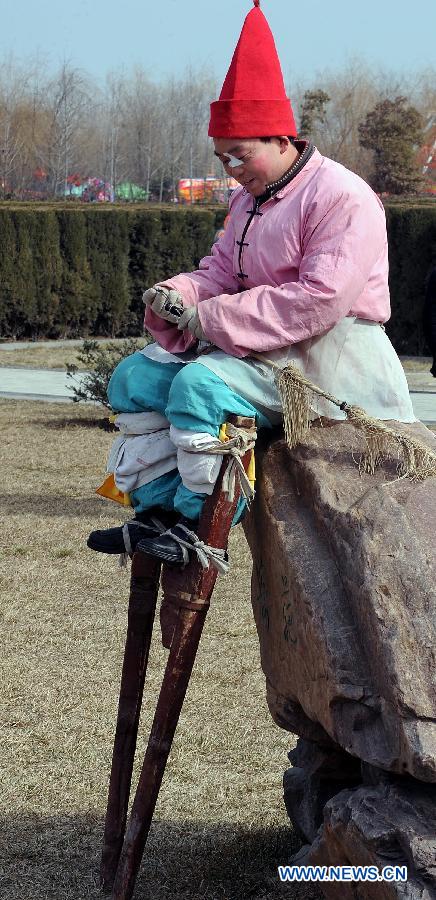
File photo taken on Feb. 17, 2010 shows a stilt artist taking a break at the interval of Shehuo performances in Luoyang, central China's Henan Province. The performance of Shehuo can be traced back to ancient rituals held by ancestors of the Chinese people to worship the earth, which they believe could bring good harvests and fortunes in return. With time, the primitive rituals evolved into the Shehuo festivity, a tribute to the Tudi Gong, a deity who holds sway over fortune and wealth. Most Shehuo performances take place around traditional Chinese festivals, especially at temple fairs of the Spring Festival and the Lantern Festival. [Xinhua/Wang Song] 
File photo taken on Feb. 24, 2000 shows citizens watching a Shehuo performance in Xinmi, central China's Henan Province. The performance of Shehuo can be traced back to ancient rituals held by ancestors of the Chinese people to worship the earth, which they believe could bring good harvests and fortunes in return. With time, the primitive rituals evolved into the Shehuo festivity, a tribute to the Tudi Gong, a deity who holds sway over fortune and wealth. Most Shehuo performances take place around traditional Chinese festivals, especially at temple fairs of the Spring Festival and the Lantern Festival. [Xinhua/Wang Song] |
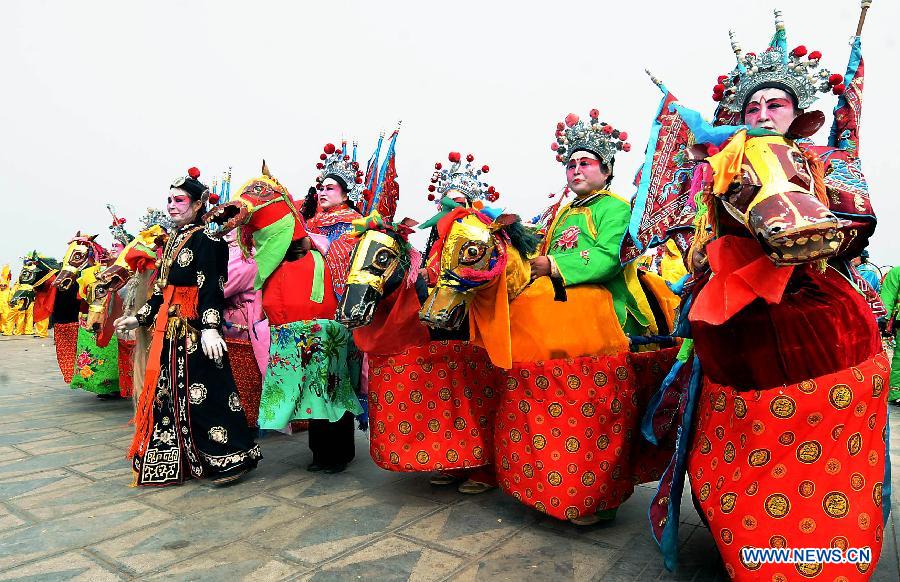
File photo taken on March 18, 2010 shows members of a Shehuo performance team preparing for shows at a temple fair in Huaiyang, central China's Henan Province. The performance of Shehuo can be traced back to ancient rituals held by ancestors of the Chinese people to worship the earth, which they believe could bring good harvests and fortunes in return. With time, the primitive rituals evolved into the Shehuo festivity, a tribute to the Tudi Gong, a deity who holds sway over fortune and wealth. Most Shehuo performances take place around traditional Chinese festivals, especially at temple fairs of the Spring Festival and the Lantern Festival. [Xinhua/Wang Song] |

File photo taken on April 27, 2002 shows villagers gathering on a rooftop to watch a Shehuo performance in Wangwu Township of Jiyuan, central China's Henan Province. The performance of Shehuo can be traced back to ancient rituals held by ancestors of the Chinese people to worship the earth, which they believe could bring good harvests and fortunes in return. With time, the primitive rituals evolved into the Shehuo festivity, a tribute to the Tudi Gong, a deity who holds sway over fortune and wealth. Most Shehuo performances take place around traditional Chinese festivals, especially at temple fairs of the Spring Festival and the Lantern Festival. [Xinhua/Wang Song] |
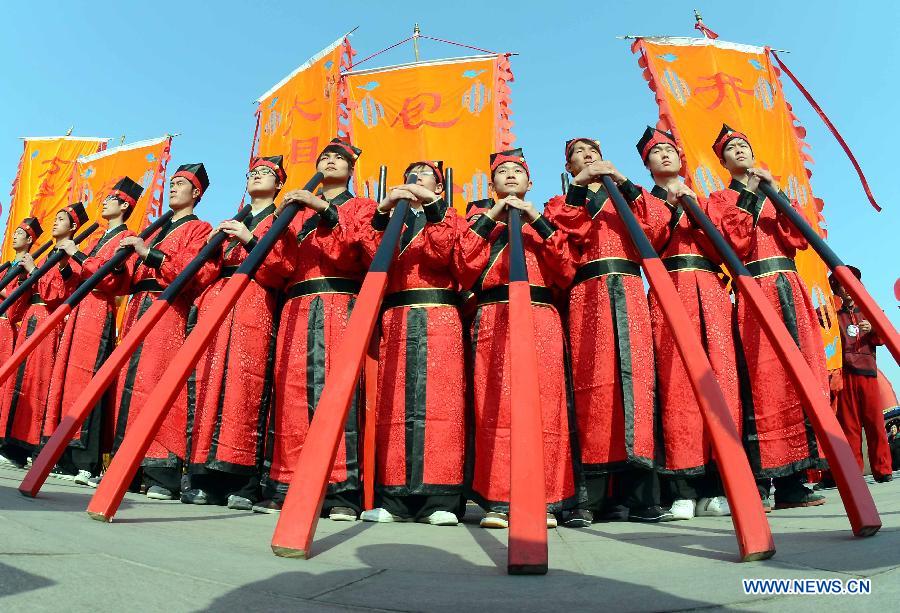
File photo taken on April 1, 2012 shows Shehuo performers attending a Qingming Festival parade in Kaifeng, central China's Henan Province. The performance of Shehuo can be traced back to ancient rituals held by ancestors of the Chinese people to worship the earth, which they believe could bring good harvests and fortunes in return. With time, the primitive rituals evolved into the Shehuo festivity, a tribute to the Tudi Gong, a deity who holds sway over fortune and wealth. Most Shehuo performances take place around traditional Chinese festivals, especially at temple fairs of the Spring Festival and the Lantern Festival. [Xinhua/Wang Song] |
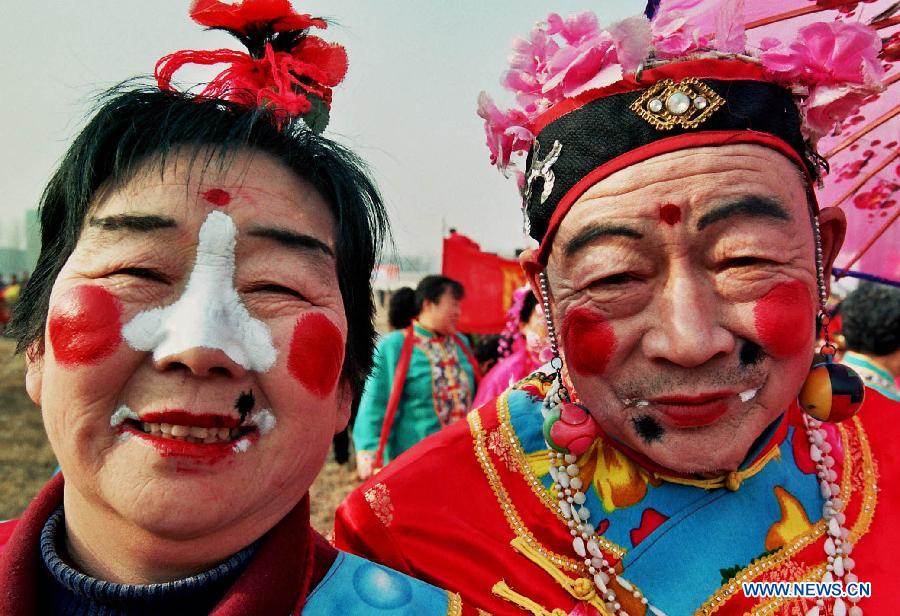
File photo taken on Feb. 13, 2002 shows two Shehuo performers at a temple fair in Zhengzhou, capital of central China's Henan Province. The performance of Shehuo can be traced back to ancient rituals held by ancestors of the Chinese people to worship the earth, which they believe could bring good harvests and fortunes in return. With time, the primitive rituals evolved into the Shehuo festivity, a tribute to the Tudi Gong, a deity who holds sway over fortune and wealth. Most Shehuo performances take place around traditional Chinese festivals, especially at temple fairs of the Spring Festival and the Lantern Festival. [Xinhua/Wang Song] |

File photo taken on Jan. 29, 2006 shows young Shehuo performers staging a drum show at a temple fair in Zhengzhou, capital of central China's Henan Province. The performance of Shehuo can be traced back to ancient rituals held by ancestors of the Chinese people to worship the earth, which they believe could bring good harvests and fortunes in return. With time, the primitive rituals evolved into the Shehuo festivity, a tribute to the Tudi Gong, a deity who holds sway over fortune and wealth. Most Shehuo performances take place around traditional Chinese festivals, especially at temple fairs of the Spring Festival and the Lantern Festival. [Xinhua/Wang Song] 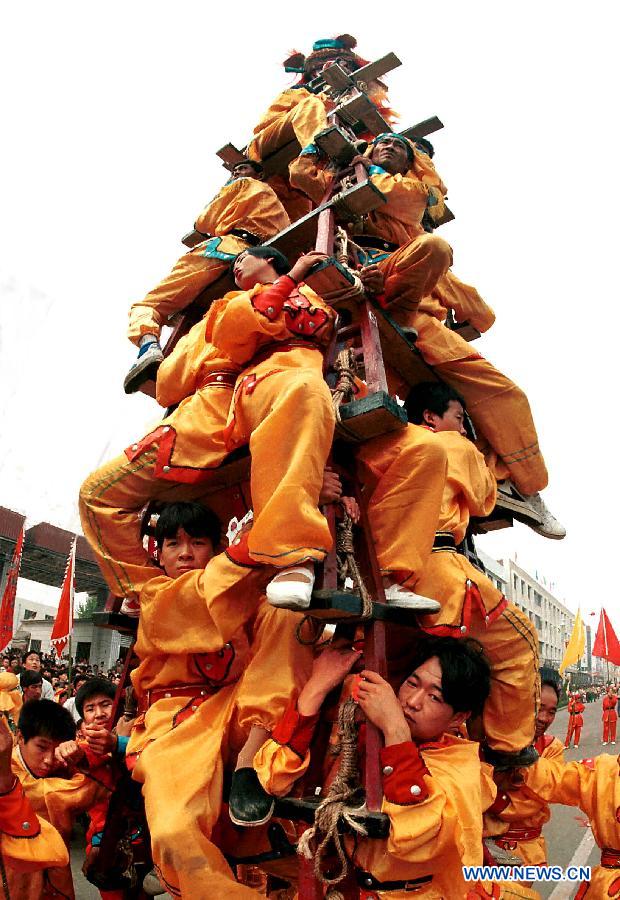
File photo taken on Feb. 24, 2000 shows folk artists staging a Shehuo performance in Xinmi, central China's Henan Province. The performance of Shehuo can be traced back to ancient rituals held by ancestors of the Chinese people to worship the earth, which they believe could bring good harvests and fortunes in return. With time, the primitive rituals evolved into the Shehuo festivity, a tribute to the Tudi Gong, a deity who holds sway over fortune and wealth. Most Shehuo performances take place around traditional Chinese festivals, especially at temple fairs of the Spring Festival and the Lantern Festival. [Xinhua/Wang Song] | 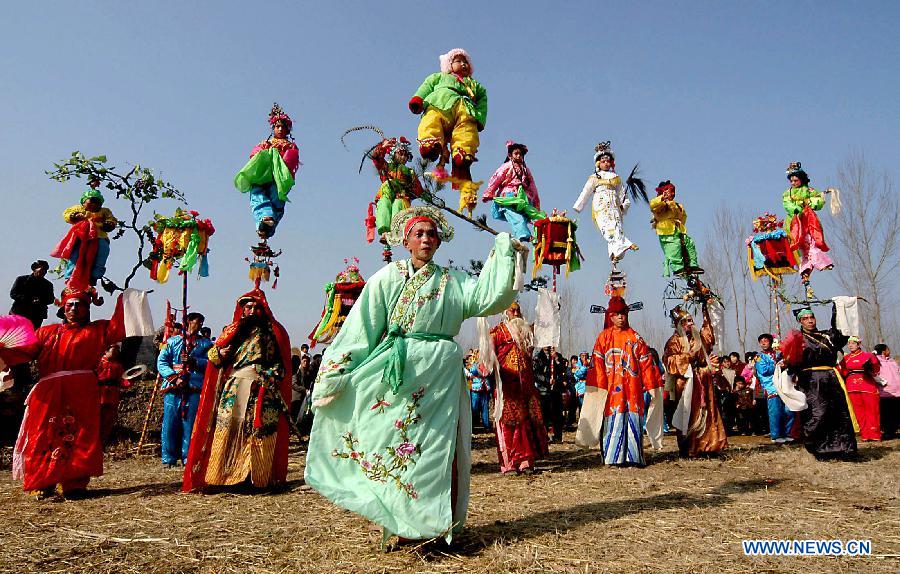
File photo taken on Feb. 11, 2006 shows Shehuo performers staging a show in Xidian Village of Songxian County, central China's Henan Province. The performance of Shehuo can be traced back to ancient rituals held by ancestors of the Chinese people to worship the earth, which they believe could bring good harvests and fortunes in return. With time, the primitive rituals evolved into the Shehuo festivity, a tribute to the Tudi Gong, a deity who holds sway over fortune and wealth. Most Shehuo performances take place around traditional Chinese festivals, especially at temple fairs of the Spring Festival and the Lantern Festival. [Xinhua/Wang Song] |
|